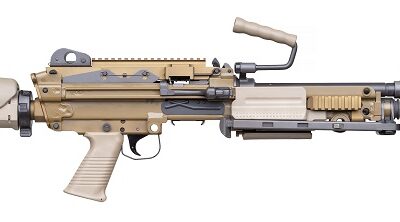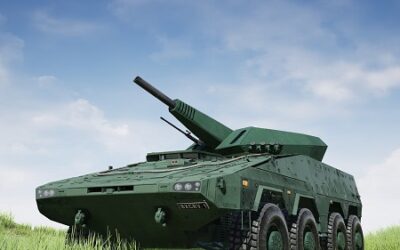Marathon’s Petroff: “2017 was a watershed year for autonomous robotic targets in the US.”
As delegates gathered for this year’s I/ITSEC, Marathon Targets’ autonomous robotic targets are being used by militaries on four continents and are rapidly emerging as the new global standard for live fire training. Ralph Petroff, Marathon’s president for the US, observed his company’s autonomous robotic targets, “are quickly morphing from an ‘exotic’ solution into a ‘mainstream’ solution.”
For example, in 2017, Marathon’s US customer base has grown to now include all the nation’s main warfighting services and one warfighting command: the Marine Corps, Army, Navy and Air Force, and US Special Operation Command.
Petroff revealed that in order to meet increased US demand, in the next three months, “Marathon will be opening three new offices to supplement our three current US offices, and more than doubling the size of its robot fleet. Each office will have a fleet of rental robots and trained robot engineers and technicians who can provide robots for two days, two weeks or two years. As an alternative to direct robot purchase – they can be provided as a ‘Training-as-a-Service.’”
Reflecting on the state of the technology in this sector, the industry veteran pointed out, “2017 has emerged as a ‘tipping point’ for autonomous robotic infantry targets. There is an accelerating consensus in the global training community that autonomous robotic targets are the future of range modernisation.”
A confluence of forces are merging to strengthen the demand for this technology: in addition to far more realistic live fire training, autonomous robotic targets can enable, “same day range modernisation;” autonomous robotic targets can turn any range into a state-of-the-art robot range in less than a day; and massive decade-long, multi-billion dollar infrastructure projects with underground utilities, and armies of maintenance contractors can be greatly scaled back.
“In a nutshell, autonomous robotic targets enable better, faster, cheaper live fire training,” the corporate leader emphasized, and explained, “Better because of the far more realistic training, and the significant marksmanship improvement documented by both USMC and the US Army; faster because range modernization can occur in a day – not a decade; faster, too, because range throughput increases geometrically – US Army and USMC have recently measured 370% – 500% increases in sniper training with autonomous robots; and cheaper because robots are far less expensive than massive construction projects, and a single robot system can do the work of five different target systems – they can function as a pop-up, mover, UKD [unknown distance] mover, live fire SITFOR [situational force], and live fire OPFOR [opposing force].”
Further, increased global demand has also greatly reduced the cost of the robots. “For example, our T40 robots have dropped by more than half since their introduction, and are now less expensive than conventional ‘movers’,” Petroff said.
Marathon has three targets moving (and shouting!) in booth 501 at I/ITSEC: T40, the new T30 and T4. “The T40 is an all-purpose robot, the T30 is up-armored for heavy volumes of fire,” the industry executive pointed out. “The T4 is a realistic 3-D pop-up target that operates on the same software. All robots flinch when wounded, and can differentiate between lethal and non-lethal shots. The robots even lean forward when running. “
Further, Marathon has also introduced a T10 indoor robot, for use in shoot houses and MOUT facilities. Petroff noted: “A small footprint and a low profile are optimal for shoot houses with limited space and narrow corridors. The T10’s collapsible dummy preserves the small footprint when the dummy is down, allowing operation close to walls, furniture, and other targetry. Like its outdoor robot ‘cousins,’ it is a talking armored robot.”
The T30 up-armored robots were delivered to the USMC in February and have reportedly received excellent reviews from shooters. “The USMC has been at the forefront of recognizing the potential benefits of autonomous robotic targets,” Petroff added.
Marathon’s patented ballistic protection enables its robots to withstand not only 5.56 ammunition, but also 7.62 machine gun fire, .338 – and even the new M855A1 ammunition. The corporate leader emphasised: “This is a significant differentiator – other prototype robot targets have not yet solved these difficult ballistic issues and are forced to operate only behind berms – greatly limiting their usefulness.”
Of significance, Marathon’s robots are not prototypes – they are 5th generation systems that have been field-proven for over nine years on four continents, with several hundred thousand miles of successful autonomous operation. Of special note, the robots have advanced Artificial Intelligence algorithms that can enable ‘swarm’ behaviors. The community subject matter expert explained: “For example – if the robots are ordered to attack – they can automatically self-deploy into multiple three robot fire teams, advancing using cover and concealment, bounding ahead with fire and maneuver. And this can be accomplished with a single keystroke – true autonomous behavior enabled by world-class AI algorithms.”
Additionally, several dozen robots can be under the command of a single operator. The operator can provide specific instructions, or let the robots operate completely autonomously. “Ground autonomous robotic operation in an unstructured environment is far more difficult than autonomy in the air or on water,” Petroff observed. “Indeed, Marathon’s robots are not just the only COTS autonomous robot targets, they remain the only autonomous ground vehicles of any kind in regular use by the military. All other autonomous ground robots remain experimental.”
Looking to 2018, Marathon expects a major increase in new contracts, “and it’s why we are doubling both our offices and our robot fleet. We expect that these contracts will not be outright purchases, but Training-as-a-Service (TaaS) contracts.” The Training-as-a-Service model is emerging as the most popular option for end-users, Petroff remarked. As procurement funds are typically more difficult to obtain than operations funds, the TaaS model is said to allow the end-user a ‘try-then-buy’ option. The Marathon leader added: “TaaS enables training events for any budget: less than $25,000, less than $100,000, or less than $1 million. And there is no risk of obsolescence in this rapidly changing field – end users can simply opt-out at the end of the service contract.”
In 2017, many thousands of global warfighters reportedly shot at Marathon targets, “including about a hundred general officers in the US alone.” Marathon has averaged a live fire demonstration every two weeks, and the company expects this tempo to increase next year.
Specifically in 2018, Marathon will be in Las Vegas during Shot Show week (23-26 January) for a variety of shoots, some open to the public and others not. “We also regularly participate in numerous competitions in the US, Australia, and the Middle East. Any end user interested in a live fire demo can contact us directly and we will do our best to accommodate them.”
Reflecting back on 2017, Petroff again emphasized this year was a watershed year for autonomous robotic targets in the US. “There is intense interest from all levels of the military, and law enforcement, including general officers, warfighters, and especially range managers.”
“We have been gratified by the overwhelming positive feedback we have received from the warfighters around the world. The most typical feedback is that live fire training with robots is ‘the best training I have received in my career’. At a recent conference, one long term robot-user described the benefits succinctly: ‘We have downed a lot of dudes on operations that we wouldn’t have gotten without the moving-target training’.”
As for 2018, Marathon further expects the new year, “will be even more exciting as more and more warfighters and range managers around the world experience firsthand the benefits of better, faster, cheaper live fire training.’”
Marty Kauchak
























